Adolf Hitler - Simple English Wikipedia, the free encyclopedia
Adolf Hitler | |
|---|---|
 Official portrait, 1938 | |
| Führer of Germany | |
| In office 2 August 1934 – 30 April 1945 | |
| Preceded by | Paul von Hindenburg (President) |
| Succeeded by | Karl Dönitz (President) |
| Chancellor of Germany | |
| In office 30 January 1933 – 30 April 1945 | |
| President | Paul von Hindenburg (1933–1934) |
| Deputy | Franz von Papen (1933–1934) Hermann Göring (1941–1945) |
| Preceded by | Kurt von Schleicher |
| Succeeded by | Joseph Goebbels |
| Führer of the Nazi Party | |
| In office 29 July 1921[1] – 30 April 1945 | |
| Deputy | Rudolf Hess (1933–1941) |
| Preceded by | Anton Drexler (Chairman) |
| Succeeded by | Martin Bormann (Party Minister) |
| Personal details | |
| Born | 20 April 1889 Braunau am Inn, Austria-Hungary |
| Died | 30 April 1945 (aged 56) Berlin, Nazi Germany |
| Cause of death | Suicide by gun |
| Citizenship |
|
| Political party | Nazi Party (1921–1945) |
| Other political affiliations | German Workers' Party (1919–20) |
| Spouse(s) | |
| Parents | Alois Hitler Klara Pölzl |
| Occupation | General of Nazi Germany |
| Profession | Artist |
| Cabinet | Hitler cabinet |
| Civilian awards | Iron Cross, First Class Iron Cross, Second Class Bavarian Military Merit Cross, Third Class with Swords Wound Badge in Black |
| Signature | |
| Military service | |
| Nickname(s) | Bohemian corporal |
| Allegiance | |
| Branch | Imperial German Army Reichswehr Wehrmacht |
| Service years | |
| Rank | Gefreiter |
| Unit | 16th Bavarian Reserve Regiment |
| Wars | World War I World War II |
| Military awards |
|
Adolf Hitler[2] (20 April 1889 – 30 April 1945) was an Austrian-born German politician and the leader of the Nazi Party from 1933 until his death in 1945. He and his Nazi government are known for causing World War II and the Holocaust, which killed millions.
Hitler was born in Braunau am Inn in Austria-Hungary and was raised near Linz. He lived in Vienna in the first decade of the 1900s before moving to Germany in 1913. He was decorated during his service in the German Army in World War I, receiving the Iron Cross. In 1919, he joined the German Workers' Party (DAP), the precursor of the Nazi Party. Hitler became the leader of the Nazi Party in 1921. In 1923, he attempted to seize governmental power in a failed coup in Munich and was imprisoned with a sentence of five years. In jail, he dictated the first volume of his autobiography and political manifesto Mein Kampf ("My Struggle"). He led them to become the most powerful political party in Germany after the 1932 elections. He began running the government when he became the Chancellor of Germany in 1933. The Nazis banned all other political parties and turned Germany into a dictatorship (meaning that the government was ruled by one person). Hitler's dictatorship is known as Nazi Germany, also known as the "Third Reich" (meaning "Third Empire" or "Third Realm"). Hitler called himself the Führer (meaning "leader") after the year 1934.
Hitler ordered the takeover of Poland in 1939, and this started World War II in Europe. Hitler made all the important decisions during the war.[3] At first, Nazi Germany did well in the war, but by 1945 they were losing. On 29 April 1945, Hitler married his longtime lover, Eva Braun, in the Führerbunker in Berlin. Less than two days later, Hitler and Braun committed suicide, as the Soviet Army got to Berlin, because they did not want to be captured alive by the Soviet Union.
Because of the Nazi government, at least 50 million people died.[4] About 28.7 million soldiers and people died in the fighting. The war also killed 19.3 million civilians and prisoners of war. Nazi forces committed many war crimes and atrocities during the war.[5] They killed their enemies sometimes with mobile death squads or put them in concentration camps and death camps. Hitler and his men persecuted and killed Jews and other ethnic, religious, and political minorities. In what is called the Holocaust, the Nazis killed six million Jews, Roma people, homosexuals, Slavs, and many other groups of people.[6]
Family background
[change | change source]Hitler's family was born in Waldviertel, in Lower Austria. At the time, the name Hitler changed in this region several times between Hüttler, Hiedler, Hittler and Hitler. The name was commonly in the German-speaking area of Europe in the 19th century.[7] The literature says that this name is descended from the Czech name Hidlar or Hidlarcek.[8]
Childhood and early adulthood
[change | change source]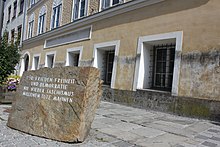
Adolf Hitler was born on 20 April 1889, as the fourth child of six[9] in Braunau am Inn. This is a small town near Linz in the province of Upper Austria, close to the border with Germany. At the time, the town was in Austria-Hungary. His parents were Klara Pölzl and Alois Hitler. Because of his father's job, Hitler moved from Braunau to Passau, later to Lambach and finally to Leonding. He attended several Volksschule's.
Hitler's mother, Klara Pölzl, was his father's third wife and also his cousin.[10] Hitler's father died in 1903. Hitler was born with only one testicle.[11][12]
Hitler failed high school exams in Linz twice. In 1905, he left school. He became interested in the anti-Semitic (anti-Jewish), Pan-German teachings of Professor Leopold Poetsch. In September 1907, he went to Vienna and took an entrance examination. On 1 and 2 October, he failed the second examination. Hitler went back to Linz at the end of October. In December 1907, Hitler's mother died and, because of that, he was depressed.[13] Hitler's mother was Catholic, but Hitler is not known to have been personally interested in Christianity.[14]
In 1909, Hitler again went to Vienna to study art. He tried to become a student at the Academy of Arts, but failed the first entrance examination.[13] He made many paintings and sold them at low prices. Hitler said he first became an anti-Semite in Vienna. This city had a large Jewish community.[15]
In 1913, Hitler was 24 years old. At that time, all young Austrian men had to join the army. Hitler did not like the Austrian army and the Austro-Hungarian Empire because of its many ethnic groups, so he left Austria for Germany. He lived in the German city of Munich.[13]
World War I
[change | change source]
On 16 August 1914, Hitler joined the Bavarian army. He fought for the German Empire in World War I. Hitler served in Belgium and France in the 16th Bavarian Reserve Regiment. He spent nearly the whole time on the Western Front. He was a runner, one of the most dangerous jobs on the Front.[16] That means he ran from one position to another, carrying messages. On 1 November 1914, Hitler became a Gefreiter (which was like being a private first class in the United States Army, or a lance corporal in the British Army). The government awarded him the Iron Cross Second Class on 2 December 1914.
On 5 October 1916, Hitler was hurt by a bullet shell. Between 9 October and 1 December, he was in the military hospital Belitz.[17] In March 1917, he went back to the front. There, he fought in a battle and was awarded with the Militärverdienstkreuz Third Class with swords.
In March 1918, Hitler participated in the Spring Offensive. On 4 August 1918, Hitler was awarded the Iron Cross First Class by the Jewish Hugo Gutmann. After Germany surrendered, Hitler was shocked, because the German army still held enemy area in November 1918.[18]
Entry into politics
[change | change source]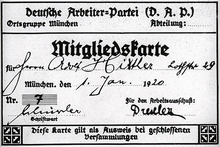
After World War I, Hitler stayed in the army and returned to Munich. There he attended the funeral march of the Bavarian prime minister Kurt Eisner, who had been killed.[19] In 1919, he participated in a training programme for propaganda speakers from 5 to 12 June and 26 June to 5 July.
Later that year, Hitler joined a small political party called the German Workers Party. He became member number 555.[20] He soon won the support of the party's members. Two years later, he became the party's leader. He renamed the party the National Socialist German Workers Party. It became known as the Nazi Party.
During the Weimar Republic
[change | change source]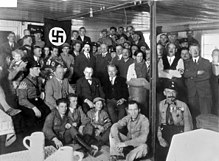
In 1923, Hitler got together several hundred other members of the Nazi Party and tried to take over the Weimar Republic government (1918–34) in the Beer Hall Putsch.[21] The coup failed. The government killed 13 of his men[22] (the 13 dead men were later declared saints in Nazi ideology). They also put Hitler in the Landsberg Prison. They said that he would stay in prison for five years, but they let him leave after nine months.
Mein Kampf
[change | change source]
While Hitler was in prison, he wrote a book with the help of his close friend Rudolf Hess. At first, Hitler wanted to call the book Four and a Half Years of Struggle against Lies, Stupidity and Cowardice. In the end, he called the book "Mein Kampf" ("My Struggle").[23]
Mein Kampf brought together some of Hitler's different ideas and explains where they came from:[24]
- His idea that the "Aryan race" was better than everybody else: This came from Arthur de Gobineau's book called The Inequality of the Human Races.
- His plans for an Empire in the East: These plans came from the way Germany had captured farming land in the First World War.
- His idea that democracy (rule by governments vote in elections) should be replaced by dictatorship (rule by one man)
- The idea that Judaism and communism were connected: He got this idea from the Nazi writer Alfred Rosenberg.
- His anger against the Jews. He suggests that they should be killed, though he is not clear about how this should be done.[25]
Hitler may also have been influenced by Martin Luther's On the Jews and their Lies. In Mein Kampf, Hitler says Martin Luther was "a great warrior, a true statesman and a great reformer."[15]
Rise to power
[change | change source]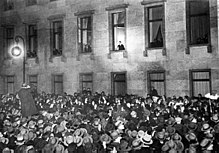
In January 1933, Hitler was elected into the German government and became a dictator in the next months. He ended freedom of speech, freedom of the press and put his enemies in prisons and concentration camps or killed them. He banned every other political party except the Nazi Party by the summer of 1933 and Germany became a one-party state.[21] Hitler and his propaganda minister, Joseph Goebbels, spread extreme nationalism within Germany. All media came under the control of the Nazi Party and they had to praise Hitler and the Nazis. Also, more people were born because Hitler wanted more people of the "master race" (those he called "Aryans"). After the death of Paul von Hindenburg in 1934, Hitler declared the office of President vacant and made himself Führer (both Head of State and Head of Government) and became a full dictator with no checks and balances. He made Germany a totalitarian fascist dictatorship.[26]
Hitler was also responsible for the Beer Hall Putsch Of 1923. In the Night of the Long Knives Of 1934 he had Ernst Röhm the head of the SA killed by Heinrich Himmler, Reinhard Heydrich and the SS. They were also involved in the Kristallnacht (1938).
World War II and the Holocaust
[change | change source]

Hitler is credited with starting World War II by ordering the German Army to invade Poland.[27] His army took over western Poland, and later most of Europe, including France and a large part of the Soviet Union.
During the war, Hitler ordered the Nazis to kill many people, including women and children. The Nazis killed around six million Jews in the Holocaust. Other people that the Nazis killed were Roma (Gypsies), homosexuals, Slavs such as Russians and Poles, and his political opponents.[28]Hitler spared his Jewish teacher also.
Finally, some of the other countries in the world worked together to defeat Germany. Hitler lost all of the lands that he had taken. Millions of Germans were killed in the war. At the end of World War II, Hitler gave all people in the Führerbunker permission to leave it. Many people did and moved to the region of Berchtesgaden. They used planes and truck convoys.
Hitler, the Göbbels family, Martin Bormann, Eva Braun and some other staff remained in the bunker.[29] Hitler married to Eva Braun on 29 April 1945.
Death
[change | change source]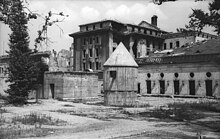

Forty hours after Hitler and Eva Braun got married in Berlin, Germany, both of them committed suicide by poisoning themselves with cyanide, Hitler also gave some to his German Shepard, then Hitler shot himself in the head with his gun.[29] Before this, Hitler ordered that their bodies be burned.[30] This prevented him from being captured alive by soldiers of the Red Army, who were closing in on him. Despite this, there are theories that Hitler did not die in 1945, but that he instead escaped to Argentina. These theories are very unpopular, with most historians dismissing them.[31]
Hitler in history
[change | change source]Ian Kershaw, a historian who wrote a biography (life story) of Hitler, describes him as a modern symbol of evil. "Never in history has such ruination ... been [linked] with the name of one man."[32] However, Kershaw and some other historians believe that it is more important to look at the wider problems in Germany at the time, rather than at Hitler himself, to explain why the war and the Holocaust happened.[33]
Related pages
[change | change source]References
[change | change source]- ↑ Evans 2003, p. 180.
- ↑ German pronunciation: adɔlf hɪtlɐ
- ↑ "BBC - History - World Wars: Hitler's Leadership Style". bbc.co.uk. 2011. Retrieved 27 April 2011.
- ↑ Both, Owen (1999). Der Zweite Weltkrieg (in German). Kaiser. p. 7. ISBN 978-3-7043-6046-5.
- ↑ This applies mainly to the SS: the Schutzstaffel, which was the Nazi security and military organisation. The regular army, known as the Wehrmacht, was a separate organisation.
- ↑ "The Holocaust: an unbelievable tragedy". Archived from the original on 18 October 2002. Retrieved 9 January 2010.[dead link]
- ↑ Jetzinger, Franz (1956). Hitlers Jugend (in German). Europa-Verlag. pp. 11 f.
- ↑ Fest, Joachim (1999). Hitler. Eine Biographie. 2. edition (in German). Ullstein. p. 43.
- ↑ Bullock, Alan (1962). Hitler: A Study in Tyranny. Penguin Books. ISBN 978-0-14-013564-0.
- ↑ Ian Kershaw (1998). Hitler 1889–1936. DVA. p. 37.
- ↑ Guardian staff. "Hitler really did have only one testicle, German researcher claims". The Guardian Nespaper. Retrieved 2023-10-15.
- ↑ Frisk, Adam. "Adolf Hitler had 1 testicle and a really small penis, according to historians". Global News. Retrieved 2023-10-15.
- ↑ 13.0 13.1 13.2 Toland, John (1977). Adolf Hitler; Biography 1889-1945 (in German). Lübbe Verlag. ISBN 978-3-8289-0540-5.
- ↑ Alan Bullock; Hitler: a Study in Tyranny; HarperPerennial Edition 1991; p218
- ↑ 15.0 15.1 Hitler, Adolf (2001). Mein Kampf. Mariner Books. ISBN 978-0-395-92503-4.
- ↑ Bullock, Allan (1962). Hitler: A Study in Tyranny. Penguin Books. ISBN 978-0-14-013564-0.
- ↑ Hitler, Adolf (2001). Mein Kampf. Mariner Books. pp. 50–51. ISBN 978-0-395-92503-4.
- ↑ Bullock, Allan (1962). Hitler: A Study in Tyranny. Penguin Books. p. 60. ISBN 978-0-14-013564-0.
- ↑ "Picture with Adolf Hitler during the march" (in German). Bibliothek der Bayerischen Staatsbibliothek. Archived from the original on 4 June 2007. Retrieved 2009-04-24.
- ↑ Toland, John (1977). Adolf Hitler; Biography 1889-1945 (in German). Lübbe Verlag. p. 131. ISBN 978-3-8289-0540-5.
- ↑ 21.0 21.1 "Biography and facts about Adolf Hitler". Retrieved 10 July 2009.
- ↑ "The Beer Hall Putsch". Chris Trueman. Retrieved 10 July 2009.
- ↑ "Spartacus Schoolnet - Mein Kampf". John Simkin. Archived from the original on 6 March 2010. Retrieved 10 July 2009.
- ↑ Laurence Rees; The Dark Charisma of Adolf Hitler; Ebury Press 2012; pp. 61–62
- ↑ Kershaw, 2008, pages, 148-50
- ↑ "Nazi Fascism and the Modern Totalitarian State". Gary Grobman. Retrieved 13 July 2009.
- ↑ "The start of World War Two". Steven Schoenherr. Archived from the original on 8 March 2002. Retrieved 2009-07-15.
- ↑ "Teachers guide - about the Holocaust". University of South Florida. Retrieved 2009-07-15.
- ↑ 29.0 29.1 "Historyplace - The death of Hitler". The History Place. Retrieved 2009-07-15.
- ↑ "Hitler, Adolf (1889 - 1945) - Credo Reference Topic". credoreference.com. 2011. Retrieved 6 September 2011.
- ↑ "Did Hitler escape from his bunker and live in Argentina after WW2? The real history that debunks the conspiracy". HistoryExtra. Archived from the original on 2023-05-08. Retrieved 2023-05-08.
- ↑ Kershaw, 2000, pages xvii and 841
- ↑ Kershaw, 2008, xxxv–xxxvi
More reading
[change | change source]| Definitions from Wiktionary | |
| Media from Commons | |
| News stories from Wikinews | |
| Quotations from Wikiquote | |
| Source texts from Wikisource | |
| Textbooks from Wikibooks | |
| Learning resources from Wikiversity | |
- Alan Bullock (1991). Hitler and Stalin: Parallel Lives. HarperCollins. ISBN 978-0-679-72994-5.
- Alan Bullock (1991). Hitler: A Study in Tyranny. ISBN 978-0-06-092020-3.
- Michael FitzGerald (2006). Adolf Hitler: A Portrait. Spellmount. ISBN 978-1-86227-322-1.
- Joachim Fest (2002). Hitler. Harvest Books. ISBN 978-0-15-602754-0.
- Ian Kershaw (1999). Hitler 1889-1936: Hubris. W W Norton. ISBN 978-0-393-32035-0.
- Lothar Machtan (2001). The Hidden Hitler. Basic Books. ISBN 978-0-465-04308-8.
- "Top 25 Adolph Hitler quotes". AZ Quotes.
Other websites
[change | change source]- Mondo Politico Library's presentation of Adolf Hitler's book, Mein Kampf (full text, formatted for easy on-screen reading)


 French
French Deutsch
Deutsch